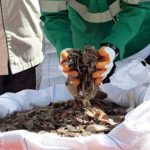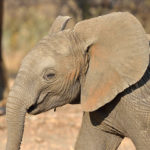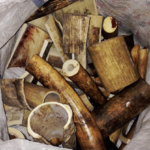The discovery of more than one and half tonnes of elephant ivory in Sri Lanka may point to the potential emergence of new trafficking routes.
Wildlife trade monitoring network, TRAFFIC, reports that Sri Lanka Customs authorities discovered the 359 tusks amongst tree logs in a shipment labelled as “plastic waste”.
It was apparently the largest confiscation of ivory ever made in Sri Lanka.
The organization said that the action was made possible by a tip off from the World Customs Organisation’s Regional Intelligence Liaison Office for Asia and the Pacific region (RILO-A/P) — highlighting the importance of global intelligence gathering and sharing.
They added that the incident could be evidence of the trade’s new smuggling routes, as it apparently originated from Uganda, shipped from Kenya, and was bound for Dubai in the United Arab Emirates (a known hub for wildlife smuggling and laundering).
However, James Compton, the Asia Programme Director for TRAFFIC, the wildlife trade monitoring network, warned that this seizure in Sri Lanka raises concerns that illegal ivory traders are developing new routes through South Asia for their illicit trade.
“As existing transit countries for African ivory such as Malaysia, the Philippines and Viet Nam increase their enforcement efforts, smugglers will adapt and seek other trans-shipping routes and substitute ports of call,” he said.
Organized crime syndicates are known to source ivory from multiple different locations and ship them together, which means the ivory seized in Sri Lanka may not necessarily have come from Uganda.
However, it may be worth nothing that elephant poaching in Uganda appears to be on the rise.
Recently, The Independent reported that 2011 was the worst year on record for Uganda’s wildlife — including at least 25 elephants that had been slaughtered for their tusks in the Murchison Falls National Park.
The Ugandan publication suggested that there may have been some kind of attempt to conceal the elephant massacre.
The audit report quotes UWA’s Monitoring and Research Department figures focusing on years between 2008 and 2011 but say the loss of the 25 elephants was concealed from them by UWA.
“The information provided by UWA is inaccurate as it was inconsistently being entered. For instance, there were incomplete figures provided for the poaching on elephants, giraffes and Oribi. Available records from the monitoring and research department (animal health monitoring) of Murchison Falls show that 25 elephants and 6 giraffes were killed in 2011,” says the report.
Apparently, Uganda has one of the smallest elephant populations in the region and has already been depleted of its rhinos — and The Independent confirmed that lion poaching is also on the rise there.





